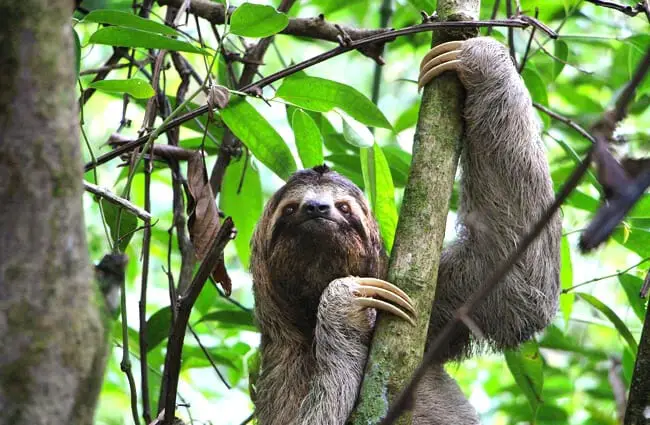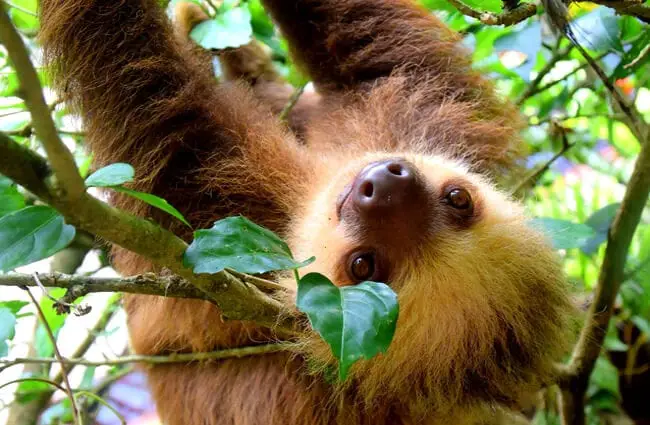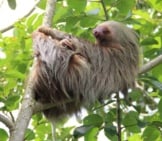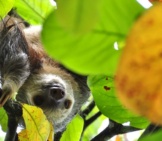Sloths are literally named for their characteristically slow movement. Adored in pop culture, sloths are the subject of many adorable viral videos, and seen in numerous movies and cartoons. There is much more to these endearing creatures than their famously slow movements. Read on to learn about the sloth.
Description of the Sloth
Sloths are built for life in the trees, where their long, curved claws are used for gripping branches. Depending on the species, the arms will have two or three long claws, which are used to hang upside down underneath branches.
All sloth species have long legs, and rounded heads with small ears. Their fur is long and coarse, and is frequently coated in green algae. This fur grows away from their extremities, unlike most other mammals. This strange growth pattern is attributed to their upside-down style of living.
Interesting Facts About the Sloth
Sloths are truly amazing and interesting creatures. While they might seem slow and boring, their lives, characteristics, and adaptations are anything but!
- Green Fur – Most sloths have a green tinge to their coats. This color comes from algae growth, and their relationship with the algae is symbiotic. This means that both creatures benefit from the interaction. The algae hitches a ride on a suitable host, and the host receives camouflage from predators, in the form of green coloration.
- Living Habitat – Sloths are a living, breathing biome! In addition to the algae that grows on their fur, sloths play host to a number of insects and other small creatures. While they carry the usual fleas, ticks, and mites, some also provide a home for many different beetle and moth species.
- Hold It! – Because these animals spend their lives hanging from trees, using the bathroom can be a challenge. Sloths only climb to the ground once per week to urinate and defecate. During this time they are in extreme danger, and must accomplish their task as quickly as possible. Most sloths live in the same tree for the bulk of their feeding time, and researchers believe that the sloth’s fecal habits actually help fertilize the tree it lives in.
- Muscular Mayhem – There is good reason for sloths to avoid climbing to the ground more often. Its total body weight is just 25 – 30% muscle. In comparison, most other mammals’ body weight is 40 – 45% muscle. These creatures are built for leisurely hanging, not walking, and they do not do well at it. Because they can’t walk, they must drag themselves using their long front limbs, making them a sitting duck for predators. Better to just stay in the trees as long as possible.
Habitat of the Sloth
Sloths are restricted to a very small ecosystem in which they can succeed. They are extremely specialized creatures, and only do well in tropical rainforests. They are arboreal creatures, which means they live the vast majority of their lives up in the treetops. They will remain on and around a single tree, known as a modal tree.
Distribution of the Sloth
All six species of sloths are found in the rainforests of Central and South America. Each species has different distribution, and some are localized to a very small range. The brown-throated sloth can be found from Honduras to Eastern Peru. The pale-throated sloth is found from Guyana to areas north of the Amazon River in Brazil. The maned sloth is found only in Brazil.
The critically endangered pygmy three-toed sloth is found only on Isla Escudo de Veraguas off the coast of Panama. The Linnaeus’s two-toed sloth is found from Venezuela to areas north of the Amazon River in Brazil. The Hoffman’s two-toed sloth is divided into two populations, one from Honduras to Ecuador, and the other from Peru to Bolivia.
Diet of the Sloth
Sloths are omnivores, eating both plants and small animals. All species feed on the leaves of the cecropia family of trees, but will also browse on a number of other plants. Sloths have also been known to feed on insects, fruits, lizards, and even carrion. They learn what foods to eat by licking their mother’s lips, and this allows baby to determine what foods are safe to eat.
Sloth and Human Interaction
Unfortunately for sloths, human interactions are very commonly detrimental. Indirectly, these plodding animals are struck by cars, and electrocuted trying to climb power lines.
They are also subjected to direct poaching, both for meat and illegally for the pet trade. Thankfully, sloths are protected and aided by a number of rescues and organizations. The Sloth Institute Costa Rica rehabilitates and releases sloths into the wild, and the Aviarios Sloth Sanctuary cares for non-releasable animals.
Domestication
Sloths have not undergone any domestication.
Does the Sloth Make a Good Pet
Sloths do not make good pets. In many places it is illegal to own one, and you can be subject to hefty fines and seizure of the animal. It is also likely that your sloth was taken from the wild, which could potentially impact the population. These animals are also quite difficult to care for, because they have very specialized diets and lifestyles.
Sloth Care
In zoos, these creatures are provided with balanced nutrition to match their diet in the wild. They are provided with commercial biscuits that are low in starch and high in fiber, to replicate their daily plant intake.
In addition to these biscuits, sloths are also fed a wide variety of different plants to browse on, as well as fresh fruits and vegetables. Their enclosures provide them with lots of climbing opportunities, and various locations to browse on leaves just like they would in the wild.
Behavior of the Sloth
These animals spend the vast majority of their time alone, and only interact with other sloths to breed. They spend most of their time in and around their “home” modal tree, where they browse for food and sleep.
When a female is ready to reproduce, she begins to call at night to any males in the area. The first male to reach her will be the one she breeds with. If multiple males arrive at the same time, they battle in a comically slow fashion, and the female mates with the winner.
Reproduction of the Sloth
Different sloth species have different gestation lengths. The female will give birth upside down, normally to a single baby. The baby will nurse for a month, but begins to taste solid foods after just ten days.
Baby sloths cling to their mothers’ stomachs until they are about three weeks old, then they begin to hang upside down on their own. Depending on the species, the baby will remain with its mother anywhere from six months to two years.











![Red Angus Closeup of a beautiful Red Angus cowPhoto by: U.S. Department of Agriculture [pubic domain]https://creativecommons.org/licenses/by/2.0/](https://animals.net/wp-content/uploads/2020/03/Red-Angus-4-238x178.jpg)












![Red Angus Closeup of a beautiful Red Angus cowPhoto by: U.S. Department of Agriculture [pubic domain]https://creativecommons.org/licenses/by/2.0/](https://animals.net/wp-content/uploads/2020/03/Red-Angus-4-100x75.jpg)

